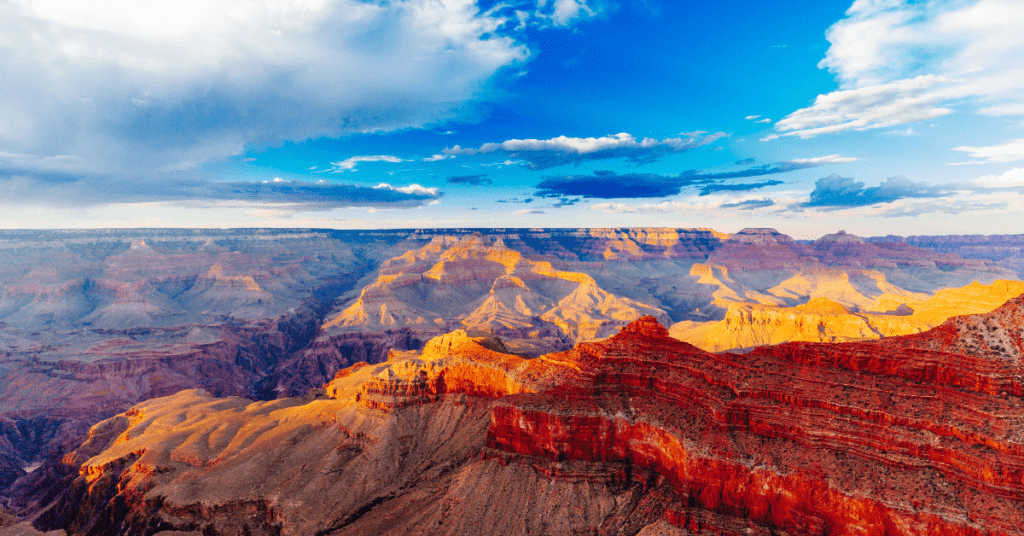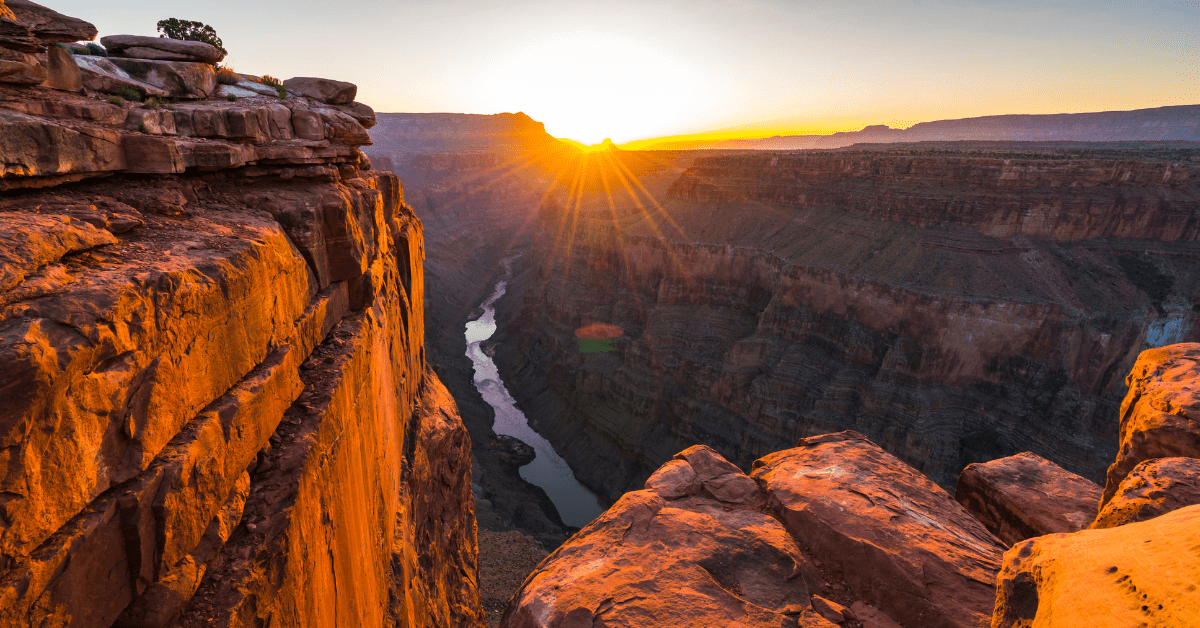Arizona: 23 national parks, national monuments, and nature reserves; 67 lakes; 25 historic sites and recreation areas; and last but not least, the Grand Canyon. All this and more is in Arizona, the Grand Canyon State in the southwest of the USA.
It is a state that is also simple to explore on a motorcycle. Because the world-famous Route 66 runs through Arizona, it is not entirely clear where the name Arizona comes from. It is believed that it comes from the O’odham language. But a Basque origin is also possible.
Arizona in numbers, data, and facts
Area: 295,254 km2
Population : *7,171,646 (estimated 2018)
Member of the USA since February 14, 1912
Time zone: UTC−7 (MST). Arizona does not observe daylight saving time, except on the Navajo Reservation.
Highest elevation: 3851 m (Humphreys Peak)
Lowest point: 21m ( Colorado River )
Average altitude: 1250 m
Capital: Phoenix
State motto: Ditat Deus (Latin: God enriches)
Arizona, on the four borders of the USA
Arizona is one of the states where the borders of four states meet. The states of Colorado, New Mexico, Arizona, and Utah make up the Four Corner States of the USA. Simple signs identify the location of the state boundary intersection, which is near US 160. The monument is a popular photo motif. After all, here in this area at the four borders, you have the opportunity to have your feet in the states of New Mexico, Utah, Arizona, and Colorado at the same time.
Weather and climate in Arizona
Arizona has a desert or steppe climate. This means the winters are mild and the summers are very hot. However, even in summer, it can get very cold at night. The highest daytime temperatures can be expected in July, sometimes exceeding 40 degrees. The coldest month is January, with around 19 degrees Celsius. Most precipitation falls in December, with the least in May and June (only 3 mm). The most hours of sunshine can be expected in June, with 13.6. The city of Yuma sees around 4,000 of these per year, making the community one of the sunniest places in the world. Snow is the exception in Arizona.
Escape the Chill: 10 Warm Christmas Getaways in the USA!
Arizona’s 10 Largest Cities
There are quite a few big cities in Arizona. Phoenix is by far the most populous city and is probably well known to most visitors to the USA.
A list of major cities at a glance:
- Phoenix (1,617,917)
- Tucson (530,706)
- Mesa (484,587)
- Chandler (247,477)
- Scottsdale (246,645)
- Glendale (245,895)
- Gilbert (237,133)
- Tempe (182,498)
- Peoria (164,173)
- Surprise (132,677)
Arizona for tourists
The Grand Canyon State has many other attractions to offer besides the Grand Canyon itself. The main attractions certainly include the metropolis of Phoenix, Route 66, the desert, the pine forests, the red stones of Sedona, and well-known sites such as the Chapel of the Holy Cross, the Vermillion Cliffs, the Meteor Crater, the Antelope Canyon, and Monument Valley.
Phoenix – a vibrant city with millions of inhabitants in the southwest of the USA
Nature, animals, and plants; many sports and leisure activities; but also a lot of culture with Spanish and Indian influence—that’s what the southern capital of the US state has to offer its visitors. Worth seeing here, for example, is the “Phoenix Museum of Art” on North Central Avenue or the “Arizona Museum of National History on 5th Street. Many exhibits from prehistoric times can also be seen here.
But this is without a doubt the top attraction in the Phoenix Musical Instrument Museum (MIM), where you can immerse yourself in the world of music and musical instruments. The museum is one of the 15 best museums in the USA. For hiking enthusiasts, the Marcos de Niza Trail near the big city is worth it. Maricopa is also not far away and, in addition to a unique flair, offers sights such as the Ak-Chin Hi-Dak Eco-Museum or the Dwarf Car Museum.
But there are also museums worth seeing in other places in the Grand Canyon State. Including, for example, the Arizona-Sonora Desert Museum, which combines the world of zoos, aquariums, natural history museums, botanical gardens, and art. The museum with various live animals is located in Tucson and is worth a visit for young and old.


National parks and natural monuments in Arizona
Up, up, and away! Arizona is a nature lover’s paradise and offers countless opportunities to spend beautiful days outdoors. Of course, the state’s national parks and natural monuments are particularly inviting to visit.
These include, for example, the following sights:
Grand Canyon National Park:
The famous Grand Canyon is undoubtedly one of the greatest natural wonders on earth and was rightly added to the UNESCO World Heritage List in 1979. The 1.6-kilometer-deep and 446-kilometer-long gorge and attraction with the Colorado River in northern Arizona can ultimately be described in just one word: breathtaking!
Canyon de Chelly National Monument:
Humans have been living in these gorges for almost 5,000 years. Much longer than any other area of the Colorado Plateau. Today, in this place called Tsegi, their houses and pictures still tell stories from those days. The national monument is managed together with the Navajo tribe, which lives there, raises livestock, and cultivates the land in the canyons.
Petrified Forest National Park:
Petrified Forest National Park is located in northeastern Arizona and is best known for its silicified wood sites. This wood also earned it the nickname petrified forest. Here you can hike in the backcountry, visit Red Basin or Martha’s Butte, or learn more about the unique forest at exhibits.
Saguaro National Park:
Tucson is home to the largest cacti in the country. The giant saguaro is the universal symbol of the American West, and the majestic saguaro cacti are found in only a small portion of the United States. This national park, which is east and west of Tucson, is responsible for protecting them. Admire the giant cacti, and be sure to watch a desert sunset.
Glen Canyon National Recreation:
Here you’ll find Lake Powell, the reservoir town of Page, and more! The Glen Canyon National Recreation Area offers countless opportunities for an active vacation on and in the water and in the backcountry. It is a vast recreational area that stretches from Lees Ferry in Arizona to the Orange Cliffs in southern Utah. Great landscapes, geological wonders, and a decent piece of human history.
Agua Fria National Monument:
The 71,000-acre Agua Fria National Monument is located about 40 miles north of Phoenix and includes two mesas and Agua Fria Canyon. The plateau landscape is beautiful and is one of the most important systems of prehistoric sites in the American Southwest. It is also a fantastic place to observe animals such as coyotes, bobcats, antelopes, eagles, and other animals.
Monument Valley:
Monument Valley is one of the most majestic and photographed places on earth. The sandstone masterpieces that rise into the desert sky here in Monument Valley Navajo Tribal Park, framed by picturesque clouds, create a landscape that is simply magnificent. Very beautiful is John Ford Point, a viewpoint named after the director, whose name is inextricably linked to the well-known Western actor John Wayne.
Cococino National Forest:
Coconino National Forest is one of the most diverse national forests in the country, with landscapes ranging from the famous red rocks of Sedona and majestic Cathedral Rock to ponderosa pine forests and from the southwestern desert to alpine tundra. An excellent place to hike mountains and gorges or fish in small lakes.
Antelope Canyon:
Antelope Canyon is the most visited slot canyon in the southwestern United States and is located near Page, Arizona. A visit to this natural wonder is worth it for young and old. Even if it’s just to take unforgettable holiday photos,
Organ Pipe Cactus National Monument:
Look and listen carefully! Life pulsates in the Sonoran Desert, an international biosphere reserve and national monument. And if you listen closely, you can hear the thousand-year history of the unique desert landscape. Take a scenic tour of the preserve, hike through the wilderness, or spend one or more nights camping. It is worth it.
Sunset Crater Volcano National Monument:
The volcano crater is an impressive example of the destruction and rebirth of a landscape. When the volcano erupted in 1085, it not only changed the landscape but also the people who lived there. Today, it is an impressive example of how nature and people can influence each other.
Vermilion Cliffs National Monument:
The Vermillion Cliffs are a geological treasure that includes the Paria Plateau, Vermillion Cliffs, Coyote Buttes, and Paria Canyon. A visit to the remote landscape is rewarded with a picturesque view of towering cliffs and deep gorges. And if you’re lucky, you might also spot the California condor there. But the absolute highlight is definitely “The wave”.
Barringer crater:
Barringer Crater is located minutes from Interstate 40 and Route 66 in northern Arizona, near Winslow. It is the best-preserved meteorite impact site in the world. Today, the crater is a popular excursion destination for the whole family. The attraction has an extensive visitor center with a 4D experience room and other attractions.
Worthwhile Things to Do in Arizona
Arizona is a paradise for those who enjoy active vacations. Whether it’s touring the national parks on foot, horseback, or by jeep, or winter sports in Flagstaff, a lot is possible in the Grand Canyon State. If you want, you can also drive along Route 66 by car or motorcycle or admire the Grand Canyon and the unique Arizona landscape from dizzying heights by helicopter.
A ride on the Apache Trail, which offers an incomparable Western experience, is unforgettable. The trail follows an ancient Indian path through the rocky canyons of the Salt River and was once created as a supply road for the construction of the Theodore Roosevelt Dam. Today, the Apache Trail follows in the footsteps of the Indians through an extremely scenic area, past several state parks and former ghost towns such as Goldfield Ghost Town. There is also a rattlesnake zoo here that you can visit.
Arizona is also an excellent starting point for exploring the Wild West of the USA. A road trip through California, Arizona and Nevada is an experience you will never forget. For such a tour through Nevada, Arizona and California, you can start from Los Angeles, for example. You should plan at least three weeks for the route from Los Angeles.
Arizona has beautiful lakes
Do you love water and are you looking for a source of relaxation? Then why not pay a visit to the state’s beautiful lakes? In addition to Lake Powell, which is probably familiar to most people, the lakes Lake Havasu, Lake Mohave, Saguaro Lake, Watson Lake, and Granite Basin Lake are worth seeing.
And if you’re excited about airplanes, you should check out the one in the Tucson Pima Air and Space Museum. Here at the Pima Air and Space Museum, visitors can expect countless aircraft and other flying vehicles from all eras and types of use.
